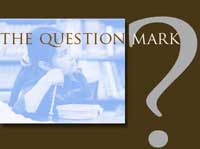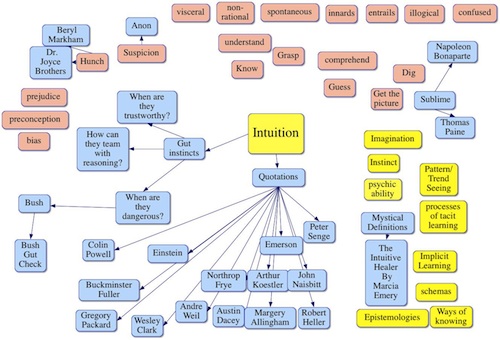While wandering about looking for new ideas, it pays to keep some kind of journal or diary where bits of information can be collected against the day when one will be doing the synthesis that converts scraps into findings and insights. Looked at singly, they may not amount to much, but viewed as part of a collection, sometimes the odd bit becomes a major clue upon which an entire invention or discovery might hinge. Without some systematic attention to storage, many of the fragments may be lost and fade from memory.
Mind-mapping software like Inspiration™ or SMART Ideas™ provides storage that is both structured and flexible, allowing the thinker to move things around, assign categories, attach images and work on the challenge of synthesizing what has been gathered. The software supports the puzzling and ruminating that should take place over time. Several years ago while preparing to do a series of workshops in New Zealand addressing the role of intuition in thinking, I created the diagram above. I collected quotations from many thinkers as well as many related words, issues and questions, much of which is concealed behind the clusters that do show on the previous page. That concealment is one of the beauties of this kind of software because it allows the thinker to keep the scraps and clues organized. The original also included color that could not be reproduced in this book.

The collection becomes rapidly cluttered as you can see above if elements are not collapsed and hidden. It is this careful organizing that helps to create the coherence required to do more than collect heaps of information. Coherence is directly related to understanding and the development of insight.
The diagram not only helped me to create the workshop but it also led to an article that was first published online and is now included somewhat changed in this book as Chapter Five — Listening to Our Intuitions. The larger the scope of the project and the greater the complexity, the more mind mapping pays dividends.
The Importance of Coherence
Coherence provides the ties that bind information into intelligible packages and the links of meaning that set us free.
The ability to find the linkages, the connections, the consequentiality and the clarity associated with coherence is the result of conscious, explicit instruction by good teachers and teacher librarians - an approach that will be outlined later in this chapter.
There are five aspects of coherence worth exploring with students so they can make powerful use of the mind-mapping software:
Connectedness
Coherence is enhanced by noting the linkages, connections, similarities and shared traits of ideas, information and concepts as well as any opposites and contrasts. We look for fit and match.
Logic
Coherence is enhanced by considering the way ideas are related in terms of meaning, as in the way that details and evidence serve like the supporting beams of a main idea, conclusion or theory.
Unity
Coherence is enhanced by resolving contrasts, conflicts and dissonance into harmony, resonance and agreement, by eliminating rough edges, inconsistencies and contradictions.
Clarity
Coherence is enhanced by reducing distractions, emphasizing pertinent ideas and facts, optimizing focus and minimizing fog, distortion and irrelevancies.
Intelligibility
Coherence is enhanced by translation of complex and difficult concepts into terms that are easier to digest, grasp and comprehend, recognizing that a picture or chart may be worth a thousand words or ten thousand data points, looking for powerful metaphors, avoiding jargon and relying upon the power of story telling to put across very challenging ideas.
|
An investment in coherence leads to findings, conclusions and discoveries that are intelligible. It is not enough to collect a huge mountain of facts and figures. They must be sorted and sifted, organized and rearranged so that they mean something. They must be condensed, simplified, summarized, interpreted and analyzed so that significance comes to the foreground.
If our students are successful in their organizing and thinking, their presentations, reports, performances or lobbying efforts will be worthy of the term coherent. As the group of words demonstrates on the next page, collecting information and then synthesizing findings into a coherent presentation is a demanding series of tasks.
Coherent
|
intelligible
|
manifest
|
clear
|
| discoverable |
unequivocal |
unblurred |
| cognizable |
unambiguous |
distinct |
| knowable |
|
clear-cut |
|
|
precise |
|
explicable
|
|
lucid |
| teachable |
|
|
|
logical
|
|
|
| meaningful |
|
|
 As students explore difficult questions and issues, they might find the Research Cycle described below a useful model to help them visualize and organize the search process. The Research Cycle was developed in 1995 to meet the need for a more robust approach to school research that might involve teams of students working on essential questions. A brief version first appeared in Multimedia Schools in June of 1995.
As students explore difficult questions and issues, they might find the Research Cycle described below a useful model to help them visualize and organize the search process. The Research Cycle was developed in 1995 to meet the need for a more robust approach to school research that might involve teams of students working on essential questions. A brief version first appeared in Multimedia Schools in June of 1995.
Stages in the Research Cycle
http://questioning.org/rcycle.html
(Stages repeated until understanding is fully developed)
1. Questioning
Researcher starts with an essential question and then develops a rich mind map of all related questions that might help to guide subsequent research.
2. Planning
Researcher thinks strategically about where to look, how to store findings and how to optimize results. Asks for support, advice and suggestions.
3. Gathering
Researcher collects information that relates to the questions asked earlier, screening to emphasize relevance and pertinence.
4. Sorting & Sifting
Researcher moves information around so that it goes where it fits. Findings are stored by categories, issues and questions.
5. Synthesizing
Researcher seeks insight by considering the information from the perspective of the essential question. Ideas and information are combined and recombined in various ways to cast light on the issue at hand. Like pieces of a jigsaw puzzle, they are rearranged until a picture emerges.
6. Evaluating
Researcher takes a look at findings and considers the adequacy of the discovery and invention process. Are pieces missing? Are there weaknesses? inadequacies? unknowns? holes in the logic or the evidence?
The researcher goes back through the stages again and again until important new insights are developed and substantiated fully.
|
After several extensive cycles through the stages above, once important new insights are developed and substantiated fully, the researcher proceeds to the sharing of insights, deciding which method of presenting might prove most persuasive and worthwhile.
At this point, the researcher is especially concerned with making findings intelligible by presenting them in a coherent manner.
A full description of the Research Cycle is available online at http://questioning.org/rcycle.html, and an expanded description of how coherence may be developed in each stage is also available online at http://fno.org/sum00/links2.html
An Example from a Writing Workshop
Working with teachers around the world on laptop writing and thinking, I challenged them to compare the courage shown by three important historical figures: Joan of Arc, Captain James Cook and Nelson Mandela.
They study the concept of courage in considerable depth the day before attempting this essay, enjoying some of the strategies outlined in the article, “Studying Complex Concepts such as Beauty, Truth and Courage in Depth” available online at http://fno.org/may2010/complexity.html
As they begin to compare and contrast the three people, they combine their musings on courage from the day before with research into their actions. The diagram starts off a bit like the one shown on the page below but ends up quite full by the end of the day. Most agree that they would need much more than one day to do the question justice. This map helps them to gather concepts, quotations, stories and many other scraps and clues that they will end up using to take and support a position.




 As students explore difficult questions and issues, they might find the Research Cycle described below a useful model to help them visualize and organize the search process. The Research Cycle was developed in 1995 to meet the need for a more robust approach to school research that might involve teams of students working on essential questions. A brief version first appeared in Multimedia Schools in June of 1995.
As students explore difficult questions and issues, they might find the Research Cycle described below a useful model to help them visualize and organize the search process. The Research Cycle was developed in 1995 to meet the need for a more robust approach to school research that might involve teams of students working on essential questions. A brief version first appeared in Multimedia Schools in June of 1995.